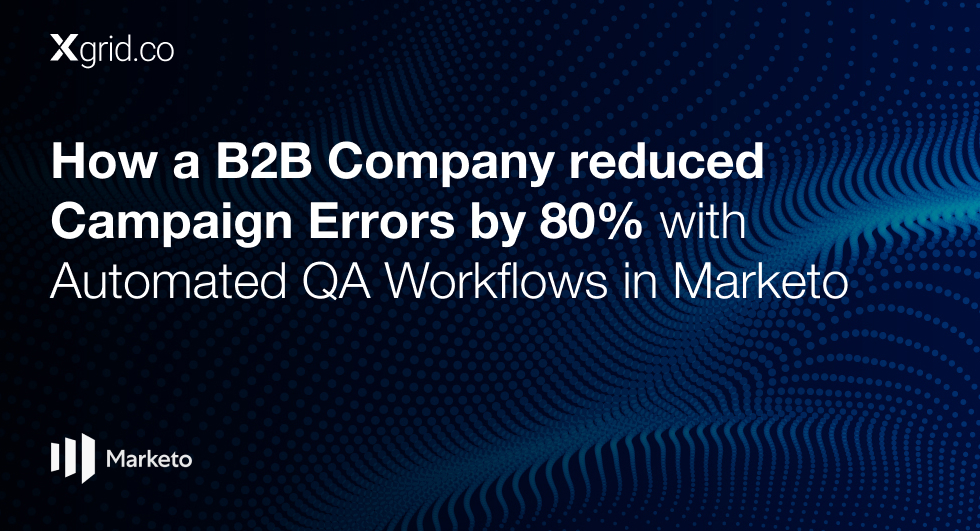How Our Marketo Reverse-Attribution Sweep Unlocked a Quarter’s Pipeline
0%
Increased Conversion Rate
0%
Revenue Preservation Improvement
Client: B2B SaaS company offering a cloud-native platform for Kubernetes & containerized application management
Tech Stack: Marketo + Salesforce
Engagement Type: Reverse Attribution Audit + Activation Pilot
Our client had strong product-market fit and a competent GTM engine. Yet, sales performance was plateauing, despite healthy MQL numbers and consistent marketing campaigns.
Marketing claimed they were delivering qualified leads. Sales, on the other hand, insisted the leads were either cold or dead on arrival. Finance wanted answers before approving additional spend. The real question lingered:
“Is there untapped pipeline in our existing database?”
Turns out, there was. And lots of it.
Forward-Looking Models Missed the Mark
The client’s team had leaned heavily on Marketo Revenue Cycle Models and Success Path Analyzer to measure funnel health. These tools were excellent at showing where leads entered and how they flowed forward—but offered little clarity on what actually led to Closed-Won.
Lifecycle stages showed motion. But motion wasn’t translating into revenue.
- No one knew which MQLs looked like actual buyers.
- Campaign attribution was stuck on “influence” instead of actionable insight.
Critical data like Opportunity Contact Roles and Campaign Member statuses were inconsistent or missing—causing attribution to break down when it mattered most.
Attribution Had to Be Reversed
Instead of obsessing over what was supposed to happen in the funnel, we flipped the model:
- We started with Closed-Won deals from the last 1–2 quarters.
- We identified the touchpoints, personas, content interactions, and recency patterns that consistently preceded conversion.
- We projected those winning patterns onto the existing MQL database to identify what we now call “Rev-Adjacent MQLs.”
These weren’t just warm leads. They were the closest statistical matches to real, recent revenue—and they were already in Marketo.
Reconstructing Revenue Patterns Across Tools
Extracts
We pulled from both Marketo and Salesforce:
- Marketo: Lead activities, program statuses, last engagement timestamps
- Salesforce: Campaign Member data, Opportunity + OpportunityContactRole records, opportunity stages, and ACV
Joins & Modeling
Using SQL and Excel, we built Cohorts of Revenue-Back Attribution:
- Segmented Closed-Won deals into high-signal clusters (e.g., who interacted with whitepapers and demo webinars within a 60-day window)
- Identified persona–content–timing patterns associated with high win rates
- Flagged matching dormant leads with “Rev-Adjacency Scores”
Data Quality Fixes
Before pattern-matching could be trusted, we:
- Ran a dedupe audit across Marketo + SFDC
- Fixed missing or inaccurate OpportunityContactRoles
- Backfilled CampaignMember data for key programs and webinars
- Standardized UTM parameters for proper source tracking
Turning Insight into Pipeline
We didn’t stop at analysis—we operationalized it.
- Built Marketo smart lists for each high-fit cohort
- Synced those lists with SDR task queues in Salesforce, prioritized by fit and recency
- Aligned email sequences and content offers to match observed patterns (e.g., “Kubernetes Resilience” whitepaper → Cluster Cost Optimization demo CTA)
- Spun up remarketing audiences on Google and LinkedIn targeting the same segments
SLA-Driven Follow-Up:
Sales was given 24–48h response windows per cohort segment. Weekly QA checks ensured no leads fell through the cracks.
Quantifiable Gains from Realignment
With a focus on process automation and attribution clarity, the client achieved:
- +25% increase in conversion rates, driven by better lead targeting and stage-specific nurturing
- 15% improvement in revenue preservation through optimized resource allocation and lead management
- Clear marketing and sales alignment, fueled by insights from revenue-pattern cohorts, not just volume-based scoring
The Success Path Analyzer finally made sense—not as a diagnostic tool, but as a confirmation of reverse-mode discoveries.
From One-Time Fix to Repeatable Revenue Ritual
We’ve since operationalized a monthly revenue-back model refresh:
- Automated extracts + joins
- Real-time alerts for newly tagged Rev-Adjacent MQLs
- Quarterly cohort reviews by Demand Gen + Sales Ops
- Forecasting reports delivered to CMO and RevOps with “Recovered Pipeline” projections
The outcome? Attribution that isn’t just a PowerPoint bullet—but a revenue-recovery engine.
Let’s find your MQLs from the database!
This case study isn’t a one-off success—it’s a repeatable playbook.Our Reverse-Attribution Audit is the first step to applying it to your business.
We’ll map your last 1–2 quarters of revenue, identify your “Rev-Adjacent MQL” pool, and give you a dollarized pipeline estimate.
Our Guarantee:If we don’t find a meaningful revenuesignal, we walk. If we do, you’ll get an actionable roadmap showing exactly who to reach, how, and why.



